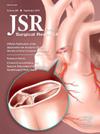A Scoping Review of Trauma-Informed Language in the Care of Injured Patients
IF 1.8
3区 医学
Q2 SURGERY
引用次数: 0
Abstract
Introduction
Trauma-informed care is a healthcare model that mitigates traumatic stress and avoids patient retraumatization. Trauma-informed language (TIL) promotes safety and autonomy to injured patients by using patient-centered language. This scoping review evaluates the literature on the education, guidance, and outcomes associated with TIL when caring for injured patients.
Methods
Cochrane CENTRAL, CINAHL, Embase, PubMed, and Web of Science were searched using terms associated with TIL, gun, gunshot, violent injury, residency, education, and emergency department. Results included studies with a focus on TIL. Case reports, commentaries, editorials, meta-analyses, and systematic reviews were excluded. Two team members reviewed records and a third resolved conflicts. The search yielded 3960 records. After 1599 duplicates were removed, 2401 studies were reviewed for abstract screening. Of the 20 studies selected for full-text review, three were eligible for this study.
Results
Included studies suggest that TIL is rarely utilized when managing injured patients. This leads to communication challenges between trauma patients and providers. When taught, TIL improves trainee communication skills. When utilized in the health-care setting, TIL improves patient satisfaction and mitigates post-traumatic symptoms in patients and physicians.
Conclusions
Understanding the impact TIL has on victims of violent injury remains elusive due to the paucity of literature. Education on TIL is essential for all clinicians to improve patient outcomes and promote health equity. Future studies should focus on evaluating pedagogical approaches to integrating TIL into trauma care with an end goal of increasing comprehensive empathy practices and enhancing patient outcomes.
求助全文
约1分钟内获得全文
求助全文
来源期刊
CiteScore
3.90
自引率
4.50%
发文量
627
审稿时长
138 days
期刊介绍:
The Journal of Surgical Research: Clinical and Laboratory Investigation publishes original articles concerned with clinical and laboratory investigations relevant to surgical practice and teaching. The journal emphasizes reports of clinical investigations or fundamental research bearing directly on surgical management that will be of general interest to a broad range of surgeons and surgical researchers. The articles presented need not have been the products of surgeons or of surgical laboratories.
The Journal of Surgical Research also features review articles and special articles relating to educational, research, or social issues of interest to the academic surgical community.

 求助内容:
求助内容: 应助结果提醒方式:
应助结果提醒方式:


